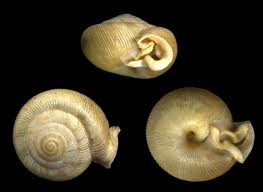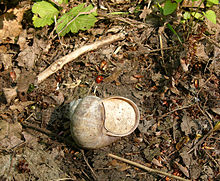
Adaptation
Size
In comparison to many other species of the gastropod, Daedalochila postelliana is relatively large with a range in size from five to ten mm (Dourson, 2010). Its' moderate size is both beneficial and harmful. Being larger gives Daedalochila postelliana an advantage in that it is easier to obtain food (for more info on what they eat see the nutrition section). However, it also means that it is easier to be spotted by predators (such as Cychrine Beetles) and because of a relatively heavy shell its slow moving speed increases its risk of being eaten (Dourson, 2010).
Radula
Daedalochila postelliana also utilizes a radula: an organ that can extend and scrape (Hickman et al. 2009). Radulas have been known to be covered with as many as 250,000 teeth that can be utilized to mash food into particles (Hickman et al. 2009). The radula may also serve as a sandpaper conveyer-like purpose for moving particles downward through the digestive system (Hickman et al. 2009).
Movement
Much like other gastropods, Daedalochila postelliana moves by means of a foot (Hickman et al. 2009). The foot is an organ comprised of muscles which contract to achieve locomotion (Hickman et al. 2009). The foot secretes mucus which is an adaptation used to help reduce the amount of friction and also serves as a barrier to prevent loss of moisture (Hickman et al. 2009).
Breathing
Snails which were once only aquatic have evolved over time to allow for migration to a terrestrial environment (Hickman et al. 2009). Unlike aquatic snails which utilize gills, terrestrial snails have converted the mantle into an air breathing lung. (Hickman et al. 2009). The opening to the lung is called a pneumostome. This structure is closed when not in use to diminish the amount of water that could be lost due to air during respiration (Hickman et al. 2009). Terrestrial snails tend to have a thicker mantle to aid in solving the water loss problem (Hickman et al. 2009).
Basal Tooth
 One of the defining characteristics of Daedalochlia
postelliana is a prominent basal tooth
One of the defining characteristics of Daedalochlia
postelliana is a prominent basal tooth
(Dourson, 2010). These teeth are within the aperture and are used by
Daedalochila postelliana to thwart any triumphant attacks
from predators that could ultimately lead to its demise (Dourson,
2010). As mentioned above in the size section the main predator of
Daedalochila postelliana is the Cychrine Beetle (Dourson,
2010).
Shell Form and Functions
An epiphragm is also used to prevent water loss (Hickman et al. 2009). The epiphragm seals the shell off when the mollusk retracts its body into its shell. (Hickman et al. 2009).
Daedalochila postelliana like most other gastropods utilizes a bisymmetrical coiling method called torsion (Hickman et al. 2009). Torsion originates during embryonic development and upon completion the anus is located right above the mouth (Hickman et al. 2009).
Nutrition is next!
Or return to the Home page.
